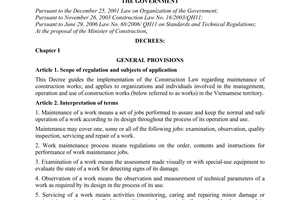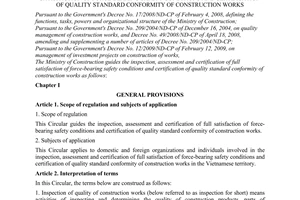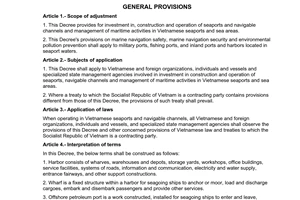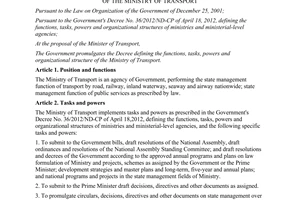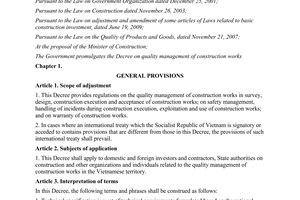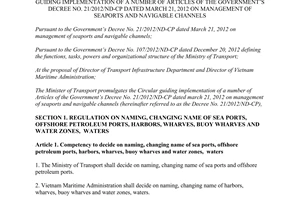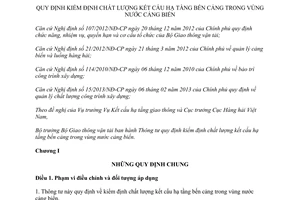Circular No. 59/2014/TT-BGTVT regulations on quality inspection for port infrastructure in port waters đã được thay thế bởi Circular 52/2017/TT-BGTVT on maintenance of maritime works và được áp dụng kể từ ngày 01/03/2018.
Nội dung toàn văn Circular No. 59/2014/TT-BGTVT regulations on quality inspection for port infrastructure in port waters
|
THE MINISTRY OF
TRANSPORT |
SOCIALIST REPUBLIC OF VIETNAM |
|
No. 59/2014/TT-BGTVT |
Hanoi, October 27, 2014 |
CIRCULAR
REGULATIONS ON QUALITY INSPECTION FOR PORT INFRASTRUCTURE IN PORT WATERS
Pursuant to the Government’s Decree No. 107/2012/NĐ-CP dated December 20, 2012 defining the functions, tasks, entitlements and organizational structure of the Ministry of Transport.
Pursuant to the Government’s Decree No. 21/2012/NĐ-CP dated March 21, 2012 on management of port and navigable channels;
Pursuant to the Government’s Decree No. 114/2010/NĐ-CP dated December 06, 2010 on maintenance of construction works;
Pursuant to the Government’s Decree No. 15/2013/NĐ-CP dated December 06, 2013 regulating management of construction quality;
At the request of Director General of Department of Transport Infrastructure and Director General of Vietnam Maritime Administration,
The Minister of Transport promulgates the Circular regulating quality inspection for port infrastructure in port waters.
Chapter I
GENERAL PROVISIONS
Article 1. Scope and regulated entities
1. This Circular regulates quality inspection for port infrastructure structure in port waters.
2. This Circular applies to organizations, individuals related to quality inspection for port infrastructure in port waters.
Article 2. Interpretation of terms
In this Circular, some terms are construed as follows:
1. Port infrastructure subject to quality inspection includes wharf and floating docks.
2. Floating dock is an anchor float equipment system, chains, anchor blocks...and other equipment established in port waters to anchor ships, load and unload goods and carry out other services.
3. Normal capability of wharf and floating docks is the ability to meet loading and operation conditions as stipulated in the initial as-built design documentation and competent agency’s announcement. In case design documentation and as-built documentation are lost, capability of wharf shall be referred to records of survey, inspection and reports of remedial works from the initial inspection of wharf infrastructure and announcement by competent agencies.
4. Wharf and floating docks are considered as out of order in the following cases:
a) Subsidence or displacement in excess of permissible value during operation;
b) Damage caused by force of collision, anchoring by ships disabling normal operation capability;
c) Damage caused to structure by impacts of loading and unloading equipment and transport vehicles disabling normal operation capability;
d) Damage caused by loading and unloading of goods disabling normal operation capability;
dd) Damage caused by meteorological, hydrological factors, natural disasters disabling normal operation capability;
e) Anchor blocks crippled, floats not guaranteeing water tightness and stability; chains and utility equipment not guaranteeing working conditions;
g) Damage caused by other special impacts;
Article 3. Principles of performing quality inspection for port infrastructure
1. Quality inspection for port infrastructure is the assessment of quality and normal operation capability of port infrastructure, ensuring marine safety and security, preventing environment pollution during the operation of port infrastructure. Quality inspection for port infrastructure includes regular and unregular inspection;
2. Regular quality inspection for port infrastructure shall be conducted in a five-year cycle as prescribed in Point c, Clause 2, Article 29 of the Government’s Decree No. 21/2012/NĐ-CP on management of ports and navigable channels; the first cycle of inspection is calculated from the date the port is put into operation.
3. Unregular quality inspection for port infrastructure shall be carried out in the following cases:
a) Upon detection of problem as prescribed in Clause 4, Article 2 hereof;
b) When design life of the works expires or re-determination of remaining life of the works must be done;
c) Upon requests of competent agencies;
4. The investor in construction of ports or organizations for port operation management (hereinafter referred to as the operation organization) shall be responsible for executing port quality inspection.
5. The operation organizations shall conduct quality inspection for ports themselves or hire consultants who must be qualified as prescribed by the law and provisions set out hereof. In case of self-inspection, the operation organization must be adequately qualified to carry out the inspection as prescribed by the law and provisions set out hereof.
Chapter II
QUALITY INSPECTION FOR PORT INFRASTRUCTURE
Article 4. Quality inspection for floating docks
1. Content and requirements for quality inspection for floating docks are instructed in National technical regulation QCVN 72:2014/BGTVT on decentralization and manufacturing of anchor floats, signal floats enclosed with the Minister of Transport’s Circular No. 24/2014/TT-BGTVT dated June 30, 2014.
2. Floating dock operation organization shall be responsible for sending result of inspection of floating docks to port authorities where floating dock belongs and Vietnam Maritime Administration within 10 working days since the result of inspection is available.
Article 5. Quality inspection for wharf
1. First regular inspection of wharf:
a) For wharves currently in normal operation, only carry out collection and visual assessment of figures on natural and operation conditions through measurements, photo-taking; comparison and assessment of current conditions against as-built documentation, design documentation to conclude capability of wharves; no calculation or auditing is required;
b) In case wharves have problems or fail to ensure quality, inspection shall be the same as regular inspection from the second cycle onwards as prescribed in Clause 2 of this Article.
2. Regular inspection from the second cycle onwards includes collection of figures on natural conditions, current operation of wharves; assessment of loading capacity of existing structures, stability of the entire works with loading and operation conditions prescribed in the initial design or in recent records of operation; assessment and proposals for capability and scale of operation in case initial operation conditions are not satisfied; determination of causes of damage and erosion to structure, and then proposals for renovation, repairs and operation conditions.
Article 6. Wharf quality inspection consultants
1. Inspection consultant must be qualified as prescribed in the Government’s Decree No. 15/2013/NĐ-CP dated February 06, 2013 regulating construction quality management; the Minister of Construction’s Circular No. 03/2011/TT-BXD dated April 06, 2011 guiding inspection, assessment and certification of satisfaction of conditions to ensure loading safety, certification of construction quality conformity and relevant regulations.
2. Operation organizations shall be responsible for selecting inspection consultant that must be qualified as prescribed in Clause 1 of this Article, other relevant provisions (in case it can not perform the inspection itself) and shall be responsible for such selection.
3. Upon submission of results of inspection to Vietnam Maritime Administration as prescribed in Article 12 hereof for approval, operation organization must enclose documented assessment of qualifications of inspection consultants.
4. For every first quarter annually, Vietnam Maritime Administration shall compile and announce a list of consultants that participate in wharf quality inspection on its website and on the Ministry of Transport’s website.
Article 7. Method, standards of survey, testing, computation in wharf quality inspection
Methods, standards of survey, testing, computation in wharf quality inspection shall be proposed by inspection consultant and approved by port operation organization in accordance with technical regulations and standards and relevant law provisions.
Article 8. Preparations for wharf inspection tasks
Before inspection is conducted, the inspection consultant must carry out the following tasks:
1. Conduct survey and formulate an outline of inspection to make the submission to wharf operation organization for approval.
2. Collect materials serving inspection including:
a) Figures on natural, topographical and geological conditions;
b) Shop drawings, as-built documents of wharf construction works; In case such documents are not available, carry out survey, drawing and measurement again to serve assessment and inspection of works' quality;
c) Recent design documents regarding repairs, renovation, upgrading and recent inspection;
d) Records of wharves, daily journal of wharf operation, documents serving port opening;
3. Prepare appropriate personnel and inspection equipment to serve the inspection
4. Equip adequate tools, personal safety equipment to ensure safety during the inspection;
Article 9. Making survey of current conditions and test of wharf structure
1. Based on figures on natural, topographical and geological conditions, make public notice in front of wharves; In case assessment of current conditions shows changes in comparison with initial design, carry out survey to supplement figures required for the inspection.
2. Make survey of dimensions and integrity of building components;
a) Make survey and full description of current conditions and surface of building components including general geometric dimensions of each component; determination of existing connection, deformation, wear of steel structures in comparison with initial design; determination of current cracks, breakage, erosion and connection of reinforced concrete structures in comparison with initial design (appearance of cracks, breakage, damage on components, determination of positions and scope of damage, cracks (length, width and depth), taking photos of current conditions; cracks of reinforced concrete, determination of positions of cracks, length, width and depth of cracks; determination of general deformation and average erosion of structures, scope and positions of local damage caused by deformation and rusts.)
b) Determine current conditions and connection between utility equipment and wharves.
c) Result of survey must represent drawings of main structures, descriptive explanation accompanied by photos at the time of inspection;
3. Make survey of deformation of wharves;
a) Survey of elevation of characteristic positions or components of wharves.
a) Survey of horizontal shift of characteristic positions or components of wharves.
c) Survey of erosion or formation of deposits in front of wharves;
d) Survey of shift, subsidence of structure behind wharves;
4. Make survey and test of technical features of main construction materials at the time of inspection; Depending on useful life as well as state of damage of existing works, the inspection consultant shall propose quantity of samples, tests as appropriate to ensure adequate grounds for assessment of construction quality.
5. Conduct assessment of current conditions of the waters in front of wharves;
a) Assess topography of the waters where ships stop and stay according to recent marine notice; In case grounds for inspection are not adequate, the inspection consultant shall make the report to the wharf operation organization for conducting survey to supplement figures as required by the inspection organization.
b) Inspect marine signal system at the waters in front of wharves (if any);
c) Assess and conclude topography of the waters in front of wharves: current elevation of bottom of the waters in comparison with the design; positions of formation of deposit, shallows, and obstacles.
Article 10. Computation and handling of wharf inspection results
1. Compute operation capability of wharves under impacts of loads and operation conditions, including:
a) Compute operation capability of wharves in terms of durability (first limit state);
b) Compute operation capability of wharves in terms of deformation (second limit state);
c) Compute overall stability conditions;
d) Compute and inspect the waters when ships stop and stay;
dd) Based on results of computation and assessment, give conclusions on working capability and operation conditions of wharf infrastructure;
2. Handle inspection results
a) Establish written records of inspection;
b) Pass written record of completion of inspection tasks Participants to pass the written record of completion of inspection tasks must comprise at least representatives of owners of the works, or operation organizations and representatives of the inspection organization that conducts the inspection. Participants to pass the written record of inspection must sign their names and affix seals on the record. Written record of inspection is part of the inspection documentation;
c) Summarize result of inspection on records of wharves;
Article 11. Wharf inspection documentation
1. Documentation of wharf inspection includes:
a) Outline of inspection;
b) Survey material: topography, geology, meteorology, hydrology, environment, current conditions of work structure (drawings, photos, explanations...);
c) Inspection report confirmed by operation organizations and inspection consultant includes main information as prescribed in Clause 2 of this Article.
2. Main information of the inspection report
a) Legal foundations:
b) General introduction about the works subject to inspection;
c) Name of operation organization;
d) Reasons for inspection;
dd) Name of inspection consultant; time and process of inspection;
e) Content of inspection;
g) Results of inspection and assessment of current conditions of wharves; used equipment and technical measures;
h) Results of quality inspection for wharf components; used equipment and technical measures;
i) Computation of loading capacity, conditions for stabilizing and operating the works;
k) Reports on loading test (if any);
l) Determine causes of damage, erosion of structures and then propose renovation and repairs (if any); propose solutions for management and operation;
m) Conclusions and petitions for quality;
n) Make updates on records of wharves;
o) Appendices regarding figures on measurements, handling and computation of the works;
p) Written records of completion of inspection tasks;
q) Relevant legal documents;
3. Documentation of inspection shall be managed under design documentation management regime and in accordance with the law provisions.
Article 12. Approval for wharf quality inspection results
1. At least 30 working days prior to regular inspection or right after completion of unregular inspection, the operation organizations must complete documentation of quality inspection.
2. The operation organization shall send 01 (one) set of written request for approval for quality inspection result directly or via the postal system to Vietnam Maritime Administration. The documentation includes:
a) Request form as prescribed in Appendix I hereof;
b) Documentation of inspection;
c) Documentation of renovation, supplements, inspection and acceptance of work items relating to quality of wharves (if any);
d) Documentation proving capacity for conducting inspection in case of self-inspection; Documentation of assessment of qualification of inspection consultants in case self-inspection can not be done.
3. Vietnam Maritime Administration shall receive, inspect and handle the documentation as follows:
a) In case the documentation is handed in directly, adequate and eligible, issue a receipt and an appointment note; otherwise, return the documentation and provide guidance to the operation organization on completion of the documentation.
b) In case the documentation is sent via the postal system, ineligible, within two working days since receipt of the documentation, Vietnam Maritime Administration shall issue a written request to the operation organization for supplements.
c) Within five working days since receipt of adequate documentation as prescribed in Clause 2 of this Article, Vietnam Maritime Administration must issue a written approval for quality inspection results according to forms as prescribed in Appendix II hereof; otherwise, issue a written reply stating the reasons;
4. The operation organization shall be responsible for carrying out repairs, remedial works and making supplements to work items according to the inspection results approved by Vietnam Maritime Administration; reporting the performance to Vietnam Maritime Administration and regional Maritime Authorities.
5. Regional maritime authorities shall be responsible for supervising, inspecting and confirming results of repairs, remedial works and supplements made to work items according to the inspection results approved by Vietnam Maritime Administration.
Chapter IV
IMPLEMENTARY PROVISIONS
Article 13. Responsibilities of Vietnam Maritime Administration
1. Organize instructions on the implementation of inspection of port infrastructure as prescribed;
2. Direct regional Maritime Authorities where the ports belong to provide instructions to relevant units on implementation of inspection of port infrastructure as prescribed;
3. Provide instructions to the operation organization on selection of fully qualified inspection consultants as prescribed hereof and relevant law provisions;
4. Organize inspection, supervision and handling of violations to quality inspection for port infrastructure as prescribed;
Article 14. Responsibilities of regional Maritime Authorities
1. Issue written notice to the operation organization about the time for performing quality inspection;
2. Inspect and supervise the implementation of inspection of port infrastructure in port waters; Only permit ships to enter and work in the ports that have satisfied quality inspection or fulfilled repairs, remedial works and supplements made to work items according to the inspection results approved by Vietnam Maritime Administration;
3. Preside over and cooperate with competent agencies in handling violations to quality inspection for port infrastructure as prescribed;
Article 15. Responsibilities of operation organization
1. Organize implementation of inspection of port infrastructure as prescribed hereof and other relevant law provisions;
2. Ensure construction quality according to the Law on Construction Quality, the Law on Management of Construction Investment;
Article 16. Responsibilities of inspection consultant
1. Ensure consultancy products are done in accordance with assigned tasks, in conformity with technical standards, regulations and law provisions;
2. Take responsibility to the law and to the management agencies for the performance, carry out compensation for any loss caused by consultancy products;
3. Fully perform obligations and responsibilities under the signed consultancy contract and law provisions;
Article 17. Effect
1. This Circular takes effect since January 01, 2015.
2. Section 6 of the Minister of Transport’s Circular No. 10/2013/TT-BGTVT dated May 08, 2013 providing guidance on implementation of a number of articles of the Government’s Decree No. 21/2012/NĐ-CP dated March 21, 2012 on management of ports and navigable channels is hereby annulled.
Article 18. Implementation
1. Department of Transport Infrastructure shall preside over and cooperate with relevant agencies and units in organizing inspection and acting as advisors for handling difficulties arising from quality inspection for port infrastructure.
2. Chief of the Ministry Office, Chief Inspector, Director General of Vietnam Maritime Administration, General Director of Vietnam Maritime Safety – North, General Director of Vietnam Maritime Safety – South and relevant agencies, organizations, and individuals shall be responsible for executing this Circular./.
|
|
THE MINISTER |
------------------------------------------------------------------------------------------------------
This translation is made by LawSoft and
for reference purposes only. Its copyright is owned by LawSoft
and protected under Clause 2, Article 14 of the Law on Intellectual Property.Your comments are always welcomed
